One of the most enjoyable parts of our hobby (in my opinion) is finding, refurbishing, and savoring an estate pipe. This thread is for any questions, experience, photos, or tricks you have to share regarding the art, science, and experimentation surrounding estate pipes. I'll kick it off with an abbreviated step by step that offers a generic outline of my process:
1. The first step for me is cleaning out the stem. I do this with isopropyl alcohol and a combination of bristle and regular pipe cleaners. I used to prefer Everclear or Bacardi 151 but when I quit imbibing I no longer had a reasonable way to use up the remainder of the bottle :) The point is to use something that will evaporate quickly after it cleans and sanitizes.
2. I then ream the bowls. I typically do this with a combination of a reamer and a pen knife- the latter being my preference. I like to take mine down to only the slightest layer of cake (1/16")- or just above bare briar. I then wipe the bowls out with a bit of alcohol and paper towels:
3. Next is the salt treatment. I fold over a pip cleaner and tuck it into the shank of the pipe before filling the bowl with kosher salt. I then take my alcohol of choice and soak the salt using an eyedropper. The eyedropper prevents getting the alcohol on the outside of the bowl where it can damage the finish. A trick I've learned is to sit the bowls in a plate of rice in order to keep them supported and upright. Afterwards, when it has leaked out tar and booze, cook it and feed it to someone you don't like ;)
4. I now return to the stems that I scrub with a micro-abrasion polishing pad, followed by a magic eraser (sometimes toothpaste with baking soda can work nicely as well):
continued in next post...
User Tag List
Results 1 to 10 of 40
Hybrid View
-
02-09-2015, 07:38 AM #1Waiting on Octember 1st


- Join Date
- Feb 2015
- Posts
- 3,384
- Ring Gauge
- 672
- Mentioned
- 359 Post(s)
- Tagged
- 0 Thread(s)
The Estate Pipe FAQ/Photo/Tricks of the Trade Thread
-
02-09-2015, 07:43 AM #2Waiting on Octember 1st


- Join Date
- Feb 2015
- Posts
- 3,384
- Ring Gauge
- 672
- Mentioned
- 359 Post(s)
- Tagged
- 0 Thread(s)
5. I return to the bowls. After the salt has leeched out all the nasty goodness (this may take 2-3 treatments of 2 hours a piece), I dump out the salt, remove the pipe cleaner, and wipe the inside with a paper towel. I then sit the bowls in an egg carton to dry for a day:

6. I like to polish using beeswax and a dremel tool with a buffing head (along with a polishing rag and some elbow grease):

7. Final product, ready to be paired up and enjoyed:


-
02-09-2015, 08:33 AM #3Royal Bum

- First Name
- Paul
- Join Date
- Feb 2015
- Location
- Central Arkansas
- Posts
- 2,707
- Ring Gauge
- 1502
- Mentioned
- 273 Post(s)
- Tagged
- 0 Thread(s)
Great post Tobias. Thanks a lot.
I picked up my first two yesterday while the wife and I were out hitting up some antique stores.
I got one that says Willard Imported Briar on the side. It is a straight pipe.
The other one is a straight pipe as well and looks similar to the Willard but has no markings at all.
I have no idea what they're worth but I only paid $25 for the pair so I think I'll be fine.
I wish I would have taken pics, but they're soaking in the salt/alcohol treatment now. I cleaned up the stems last night as well.
Looking forward to doing this more. Planning on doing some yard sale-ing when the weather warms up and I'll be on the lookout.Check out my Youtube channel, Razorback Piper Guy if you like that sort of thing.
https://www.youtube.com/channel/UCDM...i44pRZ4AP-_1OA
If heaven has no cigars, I shall not go there. - Mark Twain
It has been my experience that folks who have no vices, have very few virtues. - Abraham Lincoln
-
02-09-2015, 05:01 PM #4Jumpiní Railcars and Collectin' Cans


- First Name
- Jack
- Join Date
- Feb 2015
- Location
- Detroit
- Posts
- 544
- Ring Gauge
- 111
- Mentioned
- 22 Post(s)
- Tagged
- 0 Thread(s)
I have posted this elsewhere but since this looks like it will be a dedicated "How To" thread on cleaning up estates I think it's worth the repeat here. Due to the image restrictions I'm going to have to bust this up into several posts.
-----------------------------
I have seen a few threads on how to clean up an estate briar but only a few on cleaning up a meer. I have cleaned up two meers now and this post shows the steps I went through to clean up my second. Some of the information here was borrowed (see stole) from other sources online, and some of it I came up with myself after running into road blocks.
I'll start off by posting before and after pictures of the first meer I cleaned. It's a smooth billard with an acrylic stem and I really don't know whether it is block or pressed meerschaum, but after this second pipe I'm going to guess at pressed (more on that later).
Before:
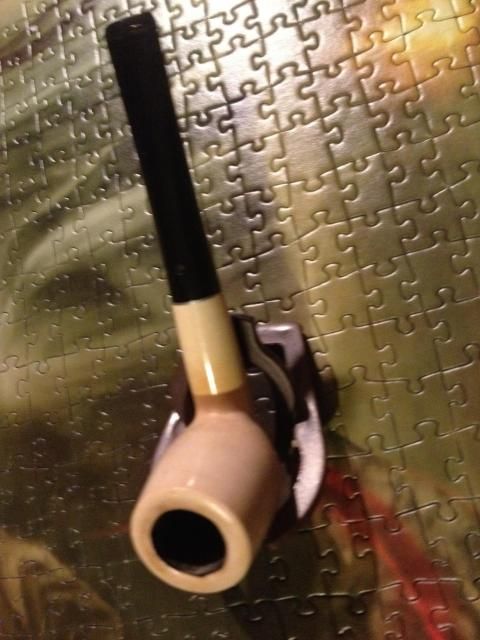
After:
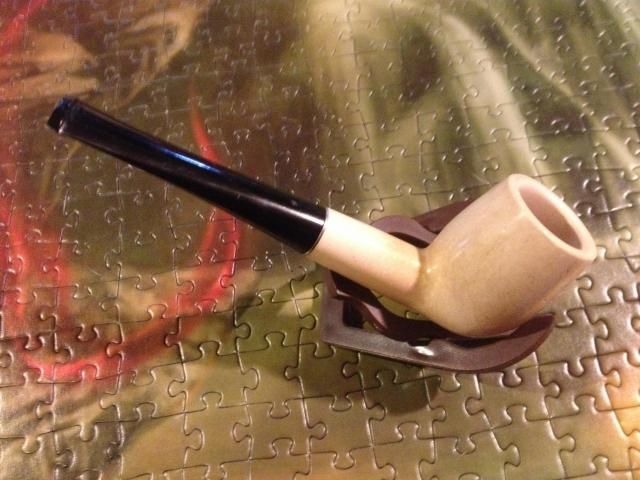
The second Meerschaum in question I picked up a few weeks ago in a local antique store for $20. This is what it looked like when I got it.
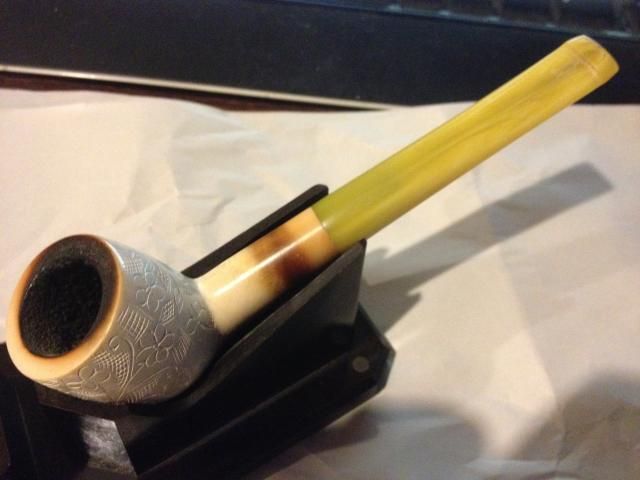
I am not sure if the stem on this pipe is bake lite or amber.
As you can see from the picture, the previous owner was not all that concerned about cake building up in his meer (very similar to the first). I brought out my senior style reamer and commenced (very carefully) to ream it out as much as I could. I have found you can only ream so much cake from a meer before other avenues are required. This is when I break out the sand paper (starting with 220 grit) and wrap it around the reamer. A loose fit works just fine as long as the sand paper will actually turn in the bowl.

-
02-09-2015, 05:02 PM #5Jumpiní Railcars and Collectin' Cans


- First Name
- Jack
- Join Date
- Feb 2015
- Location
- Detroit
- Posts
- 544
- Ring Gauge
- 111
- Mentioned
- 22 Post(s)
- Tagged
- 0 Thread(s)
The last thing I use is 000 then 0000 grade steal wool and twist it in the bowl to smooth everything out. I forget to get a pic of this process but this is the piece of steal wool I used.
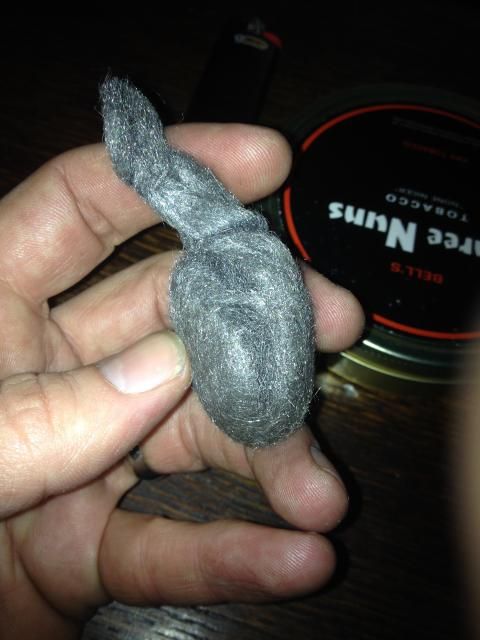
I will also take a piece of steal wool, unravel it flat, and run the top of the bowl over it on a flat surface a few times to smooth out any scratches.
Here is where I decided enough was enough.
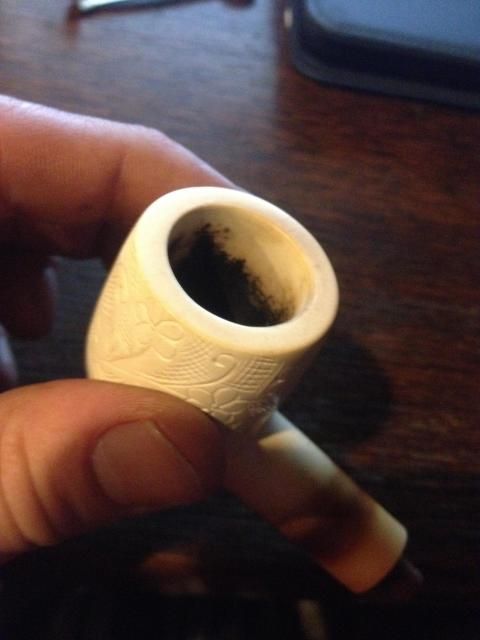
For the most part, I cleaned the stem like I would any other. Scrubbed with pipe cleaners and alcohol until it came out pretty clean. Soaked in Oxyclean and water for 24 hours and then went at it with an Arm and Hammer Magic Eraser to remove any crud. With vulcanite I may have continued with micro finishing cloth abrasive pads but did not feel it was necessary with this stem.
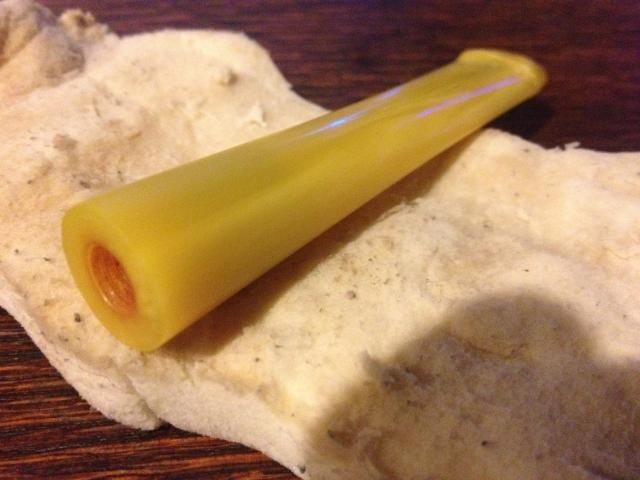
Here is where we are up to this point.
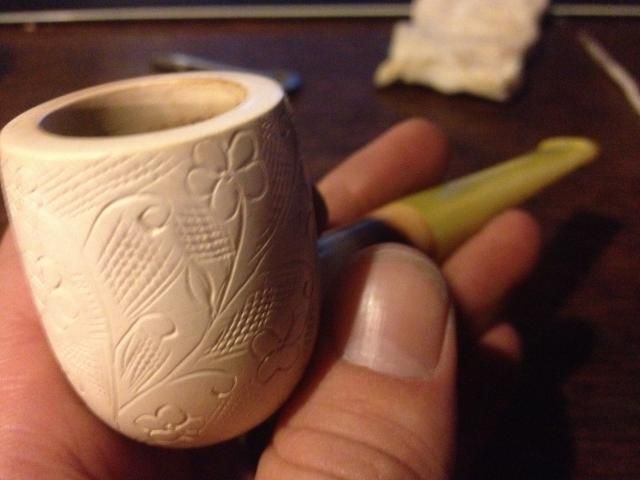
-
02-09-2015, 05:03 PM #6Jumpiní Railcars and Collectin' Cans


- First Name
- Jack
- Join Date
- Feb 2015
- Location
- Detroit
- Posts
- 544
- Ring Gauge
- 111
- Mentioned
- 22 Post(s)
- Tagged
- 0 Thread(s)
Waxing is where I started to get into unknown territory and may have mucked it all up. I have watched people melt bees wax, cork bowls, and place some type of stopper in the shank, then put the pipe in there and just stir it around. I wasn't going to do all that.
I saw a youtube of a guy that melted beeswax on a paper towel, smoked his pipe, held the pipe in the towel, and just rubbed it now and then. I did this with the smooth billard and it worked great, giving it a nice shine. On this pipe, the results were quite different.
First, instead of a paper towel I used a micro fibre cloth purchased at Harbor Freight.
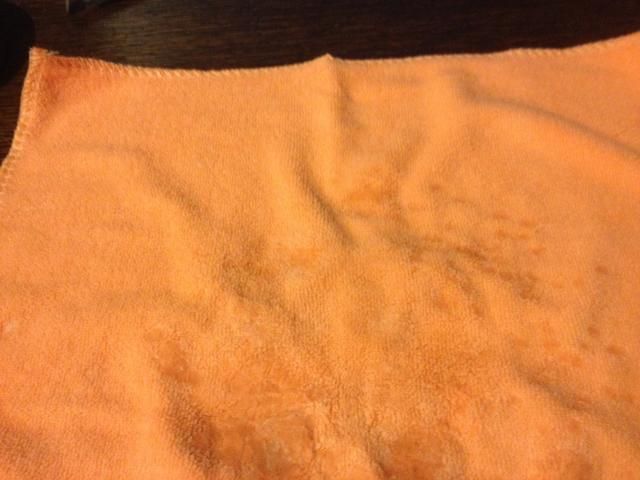
I packed my pipe with some Three Nuns and fired her up.
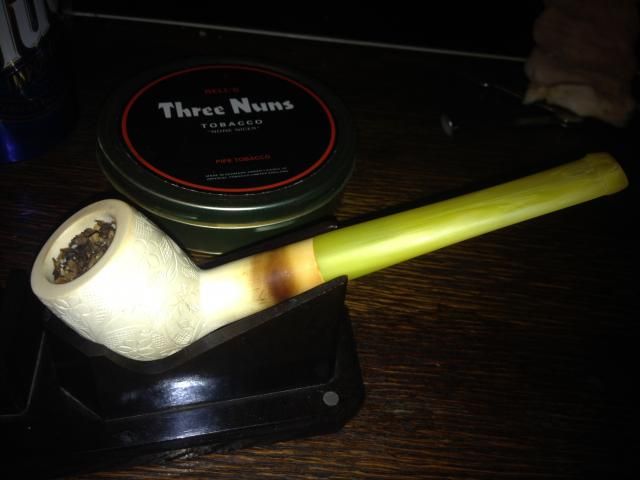
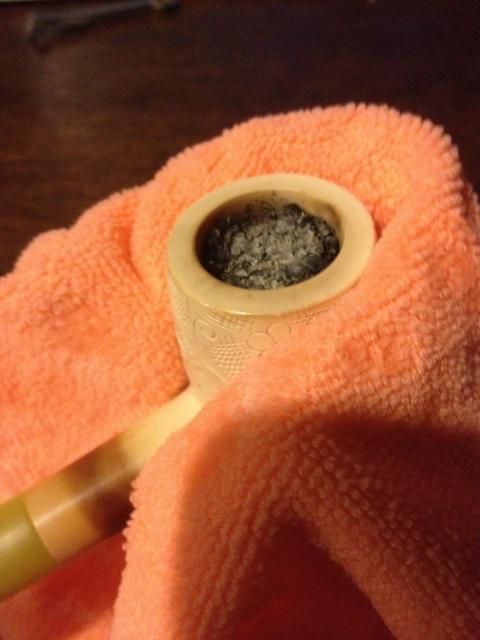
I was amazed at how much wax this pipe sucked up and how it immediately started to color. This is what I think a lot of people refer to as false coloring a meer. I'm really not sure whether it would have been better to not use wax at all but here is what the pipe looked like after just one smoke.
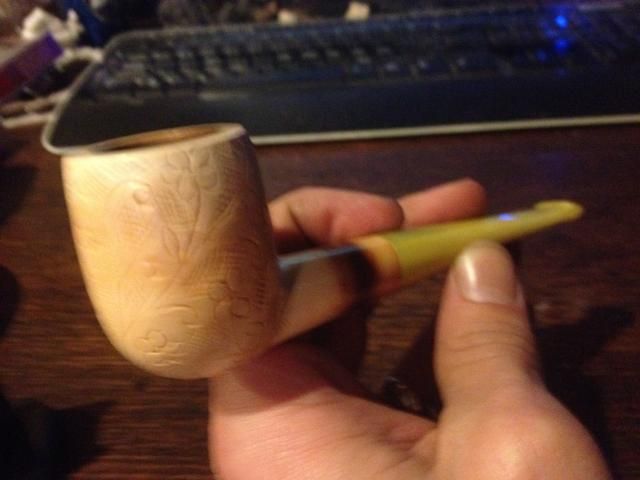
-
02-09-2015, 05:03 PM #7Jumpiní Railcars and Collectin' Cans


- First Name
- Jack
- Join Date
- Feb 2015
- Location
- Detroit
- Posts
- 544
- Ring Gauge
- 111
- Mentioned
- 22 Post(s)
- Tagged
- 0 Thread(s)
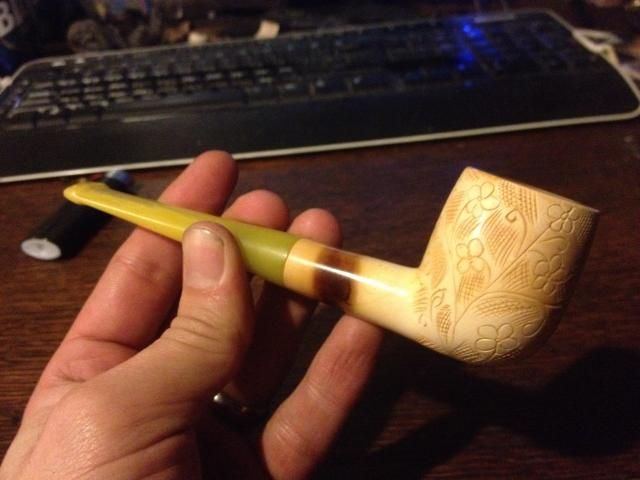
I'm starting to suspect that the first pipe was pressed meer, hence why it didn't suck up as much wax, and that this one was block.
This pipe has had two bowls through it now and I'm happy to say it's a good smoker. I hope y'all enjoyed seeing the process and as I learn more I'll share.
Kind of interesting. The closing pics were taken while the bowl was still hot. It has since cooled and much of the color has disappeared.
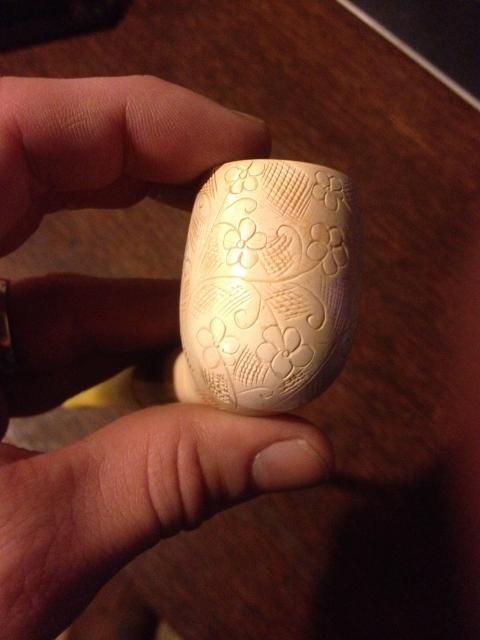
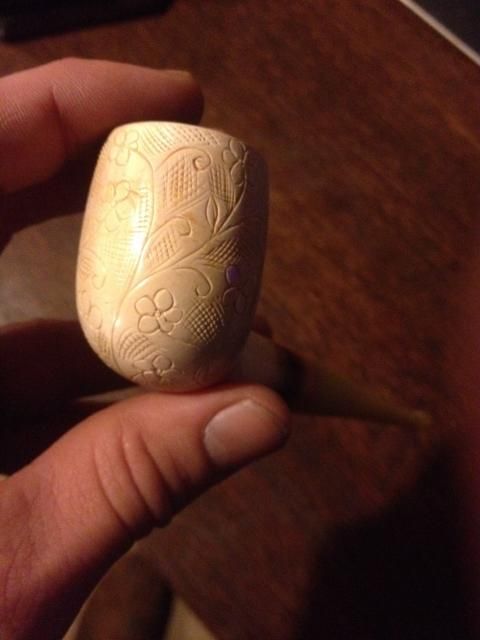
-
04-07-2015, 07:48 AM #8True Derelict


- First Name
- Pete
- Join Date
- Mar 2015
- Location
- Back in Huntington
- Posts
- 1,654
- Ring Gauge
- 535
- Mentioned
- 178 Post(s)
- Tagged
- 0 Thread(s)
Excellent thread with some great advice by people who are doing fine jobs of restoring their pipes.
Most Important before you start:
Examine the pipe and know exactly how you will restore it. Know what you can and can't do. What techniques are needed. Plan your work.
If the pipe has collectible value you need to use more care with the edges and nomenclature.
Get an inexpensive (ok - cheap, really cheap) pipe to test methods and techniques on.
Donít chase teeth indents. If you sand to flush you may compromise the integrity of the material. Judge how deep the indents are and how much material you have before starting. If the button is chewed, how far can you reduce or reshape it and have it remain useful.
Keep the pipe together when working on the stem/shank area to prevent rounding. Use tape on the shank as needed but you donít want to noticeably reduce the stem nor do you want to shave the shank. If you need to sand near the tenon, cover it with tape.
Magic erasers work well but they are mildly abrasive, more on stems than briar. Use accordingly.
Take the pipe apart when reaming to reduce the risk of tenon damage (and no soot in the stem). If youíre not experienced, try a blunt blade to ream because you donít want to nick or damage the inside of the bowl. I use the Sheffield Pipe Knife pictured below.

Materials and tools: options
@Branzig turned me onto micro-mesh pads and I also work with these (link):
http://www.amazon.com/Zona-37-948-Po...&keywords=zona
I use Bon Ami for the same purposes as Barkeeper's Friend. I just ordered 5 cans and one popped all over the rest of the order.
Retort: I use this instead of the salt bath.
Forces boiling alcohol through the stem, shank and into the bowl. Softens and dislodges old tars. Kits are available on eBay. Mine was $20 with proceeds going to Wounded Warriorís but they are available for for less.
Youíll need cotton balls, brand name Q-Tips, a shank brush and a lot of pipe cleaners.
I retort my rotation about once a year.
Pipes & Cigars sells a good shank brush (link)
http://www.pipesandcigars.com/pipe-t...7/shank-brush/
Dollar Tree has a lot of items that are useful to a pipe restorer, (please don't ask how much they cost ), including:
), including:
Brushes for cleaning the crevices of rough finished pipes (I use brushes somewhat larger than a fingernail brush)
Tooth brushes and tooth paste.
Magic eraser (store brand)
Handi-Wipe cloths (store brand)
Masking tape
-
Post Thanks / Like - 0 Thanks, 1 Likes
 Branzig liked this post
Branzig liked this post
-
02-09-2015, 05:02 PM #9Jumpiní Railcars and Collectin' Cans


- First Name
- Jack
- Join Date
- Feb 2015
- Location
- Detroit
- Posts
- 544
- Ring Gauge
- 111
- Mentioned
- 22 Post(s)
- Tagged
- 0 Thread(s)
Keep an eye on the dust you dump out of the bowl. You don't want to remove actual Meerschaum, just cake.

When the reamer stopped producing results, but I still had a noticable amount a cake in the bowl, I grabbed a deep socket that would fit in the bowl and wrapped a bit of electrical tape around it. I then wrapped the sand paper around that and kept at it.
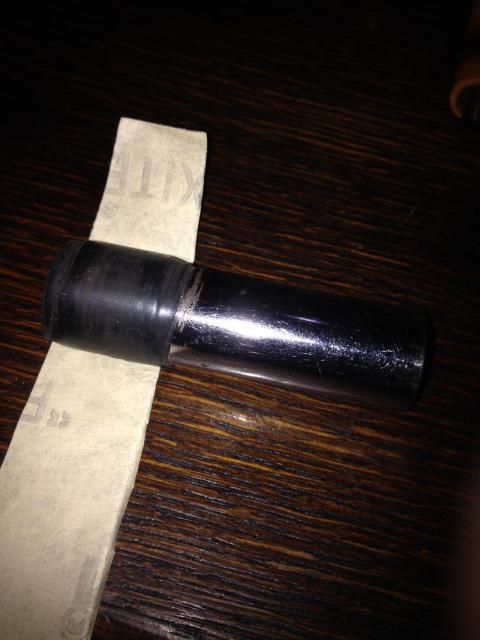
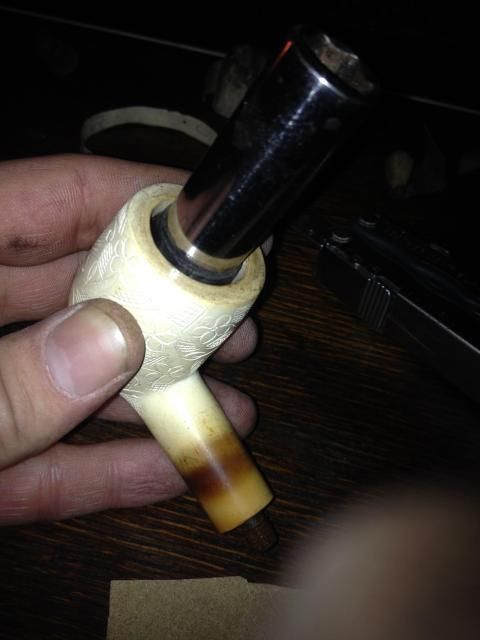
Once this stopped producing desired results I switched to wrapping a bit of sand paper around my finger...and I kept at it.
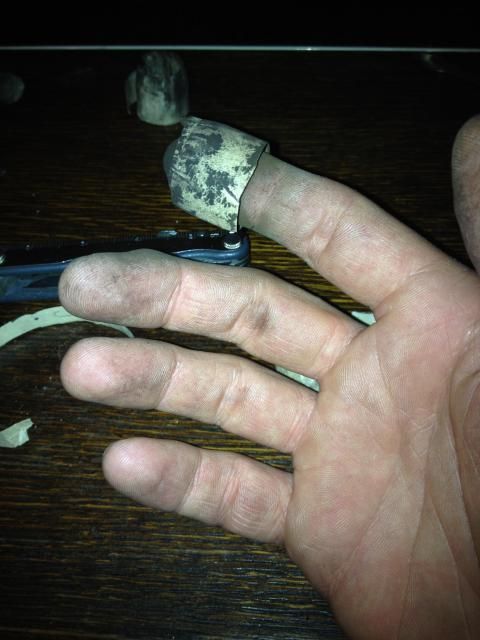
-
02-09-2015, 06:49 PM #10Lakeland Snot!

- First Name
- Brandon
- Join Date
- Feb 2015
- Location
- PNW
- Posts
- 2,019
- Ring Gauge
- 526
- Mentioned
- 102 Post(s)
- Tagged
- 0 Thread(s)
You guys just saved me a ton of work











 Reply With Quote
Reply With Quote